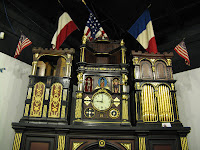High noon rolled across the country in a slow, even pace without a care for standardization and that was good enough until the country went from rutted dirt roads to smooth rails. With the extension of the railway system a person could move at such speed that the hodge-podge of times became a problem. The train couldn’t leave Philadelphia at 8 a.m. and arrive at its destinations for orderly departures without a regulated time system.
Along with the railroad system, telegraph companies stood on the side of time-standardization while others resisted holding instead to the belief that God didn’t intend for time to be defined. The sun at its peak each day was timely.
In 1870 there were 80 time zones based on the parade of shadows on sundials. By 1880 there were 56 time zones. Over the decades, as miles of train track grew, the number of time zones decreased. In 1883 the General Time Convention approved standard time zones in North America (4 in the US and 5 in Canada). On November 18 that year during “the day of two noons” the system was adopted by many people. Some communities resisted standardized time saying it was “unnatural” but over time most people accepted it so that it was mere formality when a 1918 law established standardized time.

I learned this at the National Clock and Watch Museum in York Pennsylvania where odd time pieces tick and chime with myriad pendulum heartbeats and fanciful bells in clocks tall and small, plain and fancy.
I live among clocks –grandfather, grandmother, regulator, schoolhouse, mantle and more – clocks that require a Saturday morning ritual of pulling chains and turning keys to renew the kinetic energy that keeps home time marching on – clocks built by my husband Rick. Surrounded by clocks I never thought of the fight behind establishing the right for our clocks to chime the quarter hour.
Stranger still to me was the whole Japanese concept of time using 12 segments of time – 6 in the day and 6 for the night. In the summer the daylight hours stretch but in the winter the evening hours dominated. Correspondingly, Japanese clocks were built with sliding numerals to stretch or shrink the “hours” to fit into the patterns of day and night. No matter how long the day or the night, each held 6 units of time.
This too was based on religious beliefs. People were called to prayer with one, two or three chimes so time was marked with four to nine bells with noon and midnight marked with nine bells each. God changed the length of day and night so people changed the length of hours.
In 1873, outnumbered by those following the western system, Japan accepted the 24 equal hour divisions for each day and redesigned and imported clocks.
The National Association of Watch and Clock Collectors regards time keeping as both an art and a science. It seems they are right. Museum hours change seasonally. Admission. www.nawcc.org/museum

The Engle clock, built Stephen D. Engle (1837-1921) over a 20 year period in Hazleton Pennsylvania. The clock toured the country for 70 years until 1951. It now chimes, marches, parades, peeks, whistles, plays and otherwise entertains at the National Clock and Watch museum.



No comments:
Post a Comment